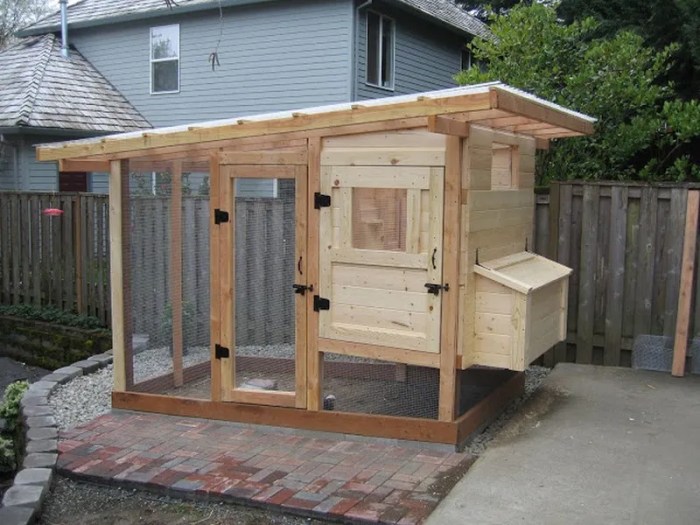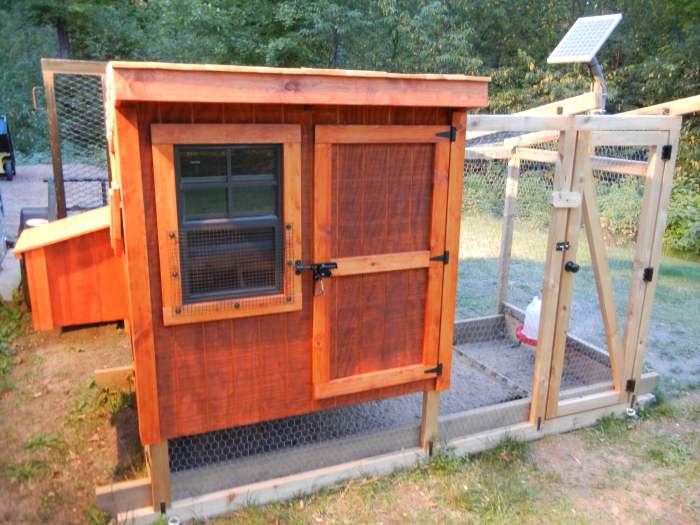DIY Chicken Coop Door: Building a Safe Haven is more than just a project; it’s a necessity for any chicken owner who wants to keep their feathered friends safe and secure. A well-constructed coop door acts as a formidable barrier against predators, ensuring your chickens can rest easy knowing they’re protected from harm.
Table of Contents
This guide will walk you through every step, from choosing the right materials to incorporating innovative security features. We’ll explore various door designs, provide practical building tips, and address common problems you might encounter along the way. Whether you’re a seasoned DIY enthusiast or a beginner, this comprehensive resource will equip you with the knowledge and confidence to build a coop door that’s both sturdy and stylish.
Integrating a Chicken Coop Door with the Coop Design
A well-integrated coop door is crucial for the functionality and usability of your chicken coop. It allows for easy access to your flock, facilitates cleaning and maintenance, and enhances the overall security of your coop.
Door Placement
The placement of the coop door is essential for both functionality and aesthetics. It should be located in a convenient spot for you to access the coop, but also consider the needs of your chickens.
- Accessibility: The door should be easily accessible for you to enter and exit the coop, especially if you need to carry feed or cleaning supplies. A door that opens inwards can be a good option for easy access, while a door that opens outwards can provide more space inside the coop.
- Chicken Comfort: The door should be placed in a location that minimizes disturbance to your chickens. Consider their natural flow of movement within the coop and avoid placing the door in a high-traffic area.
- Security: The door should be located in a position that minimizes the risk of predators gaining access. Consider placing the door in a well-lit area and away from potential entry points for predators.
Door Size
The size of the coop door is crucial for ensuring easy access and safe passage for both you and your chickens.
- Human Access: The door should be wide enough for you to comfortably enter and exit the coop, even if you are carrying heavy items. A standard door width of 30 inches (76 cm) is a good starting point.
- Chicken Access: The door should be tall enough for your chickens to pass through easily, especially if you have large breeds. A door height of at least 40 inches (102 cm) is recommended.
- Coop Design: The size of the door should be proportionate to the overall size of the coop. A small door in a large coop can look disproportionate, while a large door in a small coop can feel overwhelming.
Door Design
The design of the coop door should be functional, secure, and aesthetically pleasing.
- Materials: Choose durable materials for the door, such as wood, metal, or a combination of both. Consider the climate in your area and select materials that can withstand the elements.
- Security Features: Include security features like a latch, hasp, and padlock to prevent unauthorized access. A strong hinge is also essential for a secure and durable door.
- Ventilation: If your coop has limited ventilation, consider incorporating a small window or vent in the door to allow for air circulation.
Adding Automation to a Chicken Coop Door: Diy Chicken Coop Door
Automating your chicken coop door can significantly enhance convenience and security, making life easier for both you and your feathered friends. An automated system takes the guesswork out of managing your coop’s daily routine, ensuring your chickens are safe and comfortable, regardless of your schedule.
Timer-Based Systems
Timer-based systems offer a straightforward and reliable approach to automating your coop door. These systems use a pre-programmed schedule to open and close the door at specific times.
- Simplicity: Timer-based systems are generally easy to install and configure, requiring minimal technical expertise.
- Predictability: They provide a consistent routine, ensuring your chickens are safely locked in at night and released in the morning, regardless of weather conditions.
- Cost-Effectiveness: Timer-based systems are often the most affordable option for automating a coop door.
Light Sensors
Light sensors offer a more dynamic approach to coop door automation, responding to changes in ambient light levels.
- Natural Timing: Light sensors automatically open the door at sunrise and close it at sunset, mimicking the natural light cycle.
- Flexibility: This approach is ideal for locations with varying sunrise and sunset times throughout the year.
- Energy Efficiency: Light sensors consume minimal energy, making them an environmentally friendly option.
Remote Control Systems
Remote control systems provide the ultimate flexibility and convenience for managing your coop door.
- On-Demand Control: These systems allow you to open and close the door remotely, using a smartphone app or a physical remote.
- Increased Security: Remote control systems can be particularly useful in situations where you need to access the coop from a distance.
- Flexibility: They allow you to adjust the door’s schedule based on your specific needs, such as opening it early for a quick check or closing it later due to unexpected circumstances.
Installing and Configuring an Automated Door System
Installing and configuring an automated coop door system typically involves the following steps:
- Choosing a System: Select a system that best suits your needs and budget, considering factors such as ease of installation, features, and compatibility with your coop’s design.
- Preparing the Coop: Ensure your coop is adequately prepared for the automated system. This may involve reinforcing the door frame or adding a mounting plate.
- Installing the Hardware: Mount the motor, sensor, and control unit according to the manufacturer’s instructions.
- Connecting the Components: Wire the motor, sensor, and control unit together, ensuring proper connections and grounding.
- Programming the System: Configure the system’s settings, such as the opening and closing times or the light sensitivity level.
- Testing the System: Thoroughly test the system to ensure it functions correctly and safely.
Important Note: When installing and configuring an automated coop door system, always prioritize safety and security. Ensure the system is properly installed and functioning correctly to prevent accidental injuries to your chickens or unauthorized access to your coop.
Maintaining a Chicken Coop Door

A well-maintained chicken coop door is essential for the safety and well-being of your flock. A functional door keeps predators out and your chickens secure, while a sturdy door ensures their safety and prevents escapes.
Inspecting and Cleaning the Chicken Coop Door
Regularly inspecting and cleaning your coop door is crucial for maintaining its functionality and extending its lifespan. This involves checking for any signs of wear and tear, cleaning accumulated dirt and debris, and ensuring all components are in good working order.
- Inspect the door frame: Look for any cracks, warping, or loose screws that could compromise the door’s structural integrity.
- Check the hinges: Ensure they are securely attached and move smoothly without any squeaking or binding. Lubricate them with oil if necessary.
- Examine the latch: Verify that the latch engages properly and securely locks the door. Replace any worn or damaged parts.
- Clean the door surface: Remove any accumulated dirt, dust, or debris with a damp cloth. This helps prevent corrosion and ensures a smooth operation.
- Inspect the weatherstripping: Check for any gaps or damage in the weatherstripping that could allow drafts or pests to enter the coop. Replace any worn or damaged sections.
Safety Precautions for Building a Chicken Coop Door

Building a chicken coop door requires using tools and materials that can be dangerous if not handled properly. Taking safety precautions is essential to prevent injuries and ensure a successful project.
Using Power Tools Safely
Power tools can be incredibly helpful for building a coop door, but they also pose a risk if not used correctly.
- Always wear safety glasses to protect your eyes from flying debris.
- Use a dust mask or respirator to avoid inhaling sawdust or other particles.
- Make sure the power cord is not damaged and is plugged into a properly grounded outlet.
- Keep your fingers and hands away from the blade or rotating parts of the tool.
- Use the appropriate tool for the job and follow the manufacturer’s instructions for safe operation.
Working with Sharp Objects Safely
Sharp objects, such as knives, saws, and chisels, can cause serious injuries if not handled with care.
- Always use a cutting mat or a stable work surface to prevent slipping and accidental cuts.
- Keep your fingers and hands away from the blade’s path when cutting.
- Use a push stick to guide wood through saws and avoid getting your fingers too close to the blade.
- Store sharp objects in a safe place, out of reach of children and pets.
General Safety Precautions, Diy chicken coop door
- Wear work gloves to protect your hands from splinters, cuts, and abrasions.
- Wear hearing protection, such as earplugs or earmuffs, when using power tools or working in a noisy environment.
- Keep your work area clean and free of clutter to prevent tripping and falls.
- Be aware of your surroundings and avoid distractions while working.
- If you are unsure about a step or procedure, consult a professional or refer to a reliable source of information.
Building a DIY chicken coop door is a rewarding experience that combines practicality with creativity. You’ll gain a sense of accomplishment knowing you’ve created a safe haven for your chickens while adding a personal touch to your coop. Remember, a well-built door is an investment in your flock’s well-being and peace of mind. So, grab your tools, gather your materials, and embark on this DIY journey to create a coop door that’s as strong as it is beautiful.
Building a DIY chicken coop door can be a fun and rewarding project, especially if you’re looking for a way to keep your feathered friends safe and secure. You might even consider incorporating a small window in the door for better ventilation. Of course, if you’re dealing with high cholesterol, you might want to check out atorvastatin tablet for potential solutions.
Once your coop door is complete, you can enjoy watching your chickens roam freely in their safe and comfortable home.


